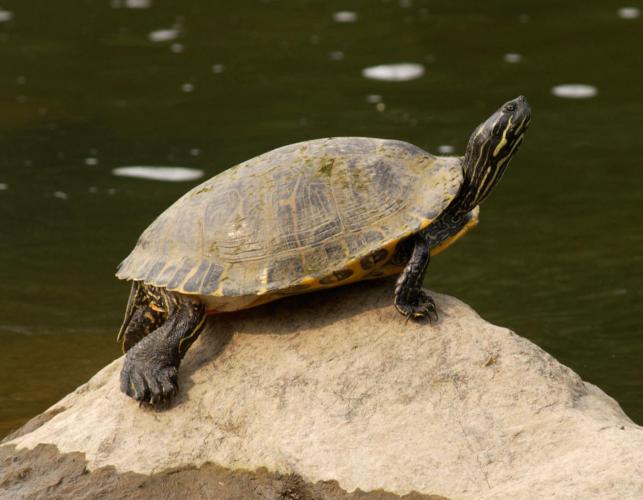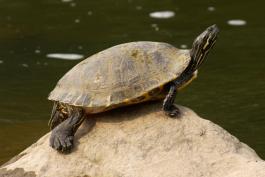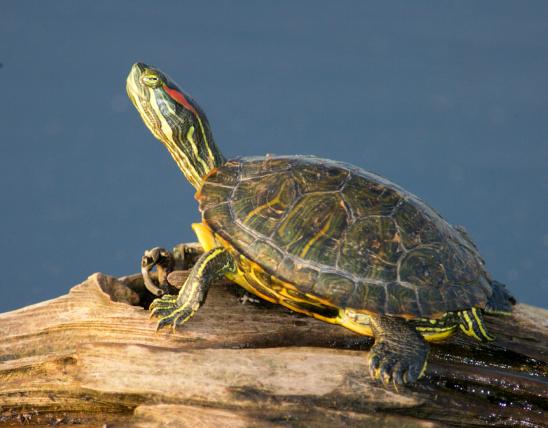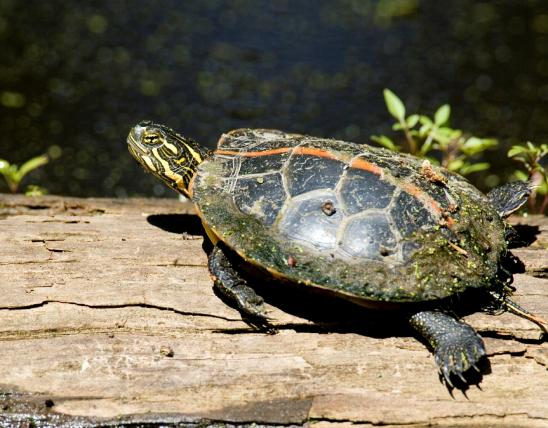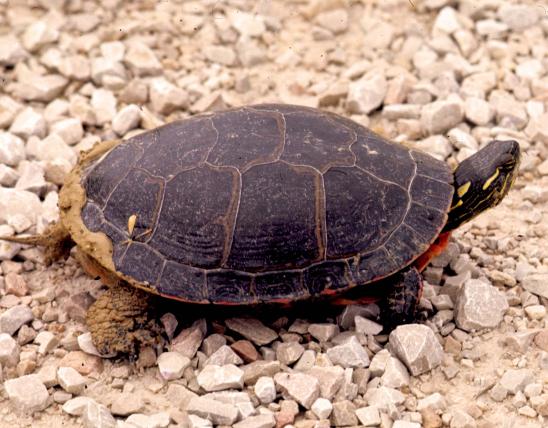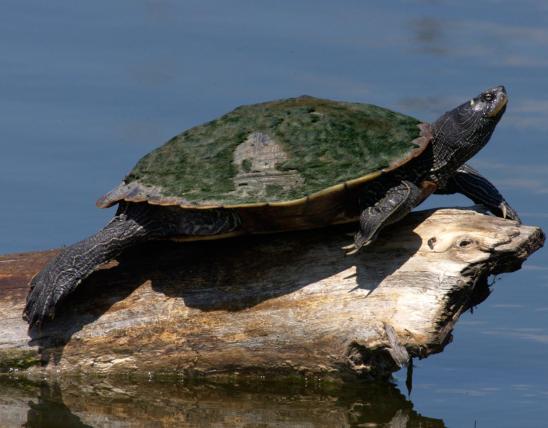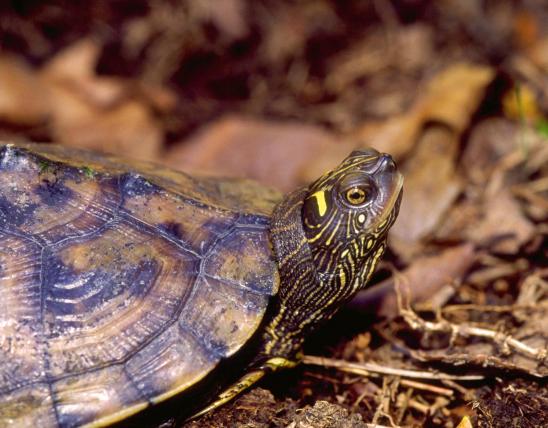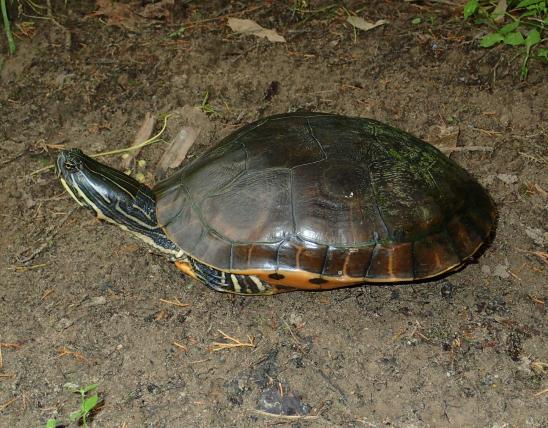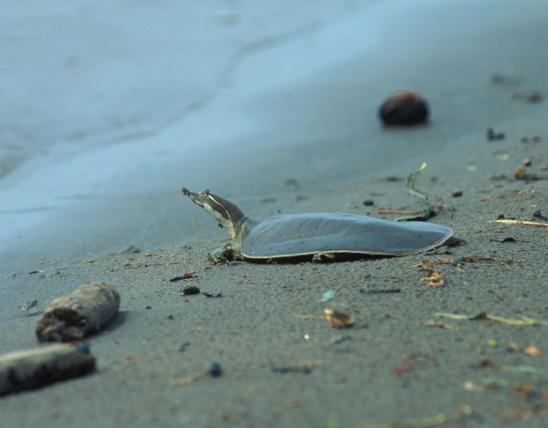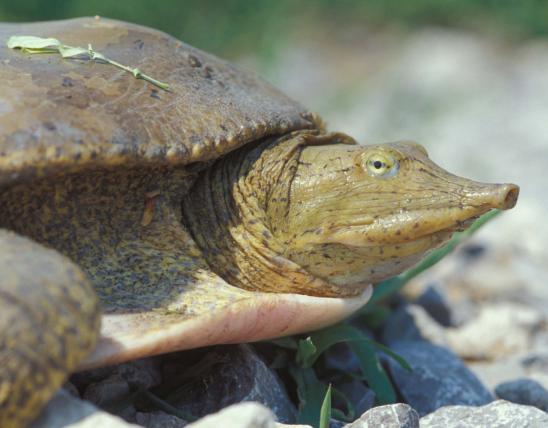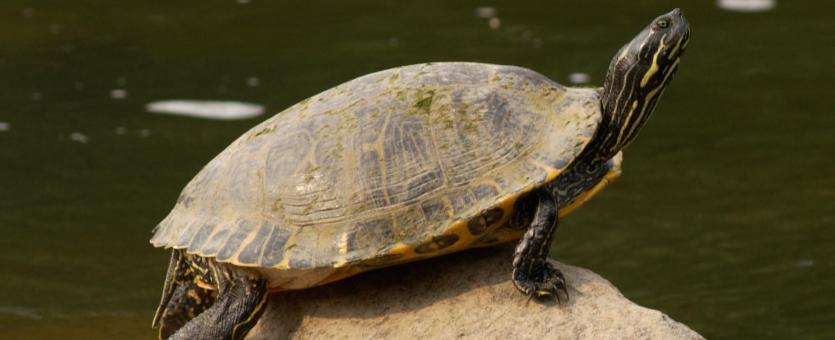
The eastern river cooter is a medium-sized aquatic turtle with a broad shell that is usually oval. The carapace (upper shell) is olive brown, brown, or nearly black, with numerous yellow lines or markings; these markings include backward-facing C-shaped, yellow marks on the first, second, and third pleural scutes (rib-covering shell scales). The rear margin of the upper shell is weakly serrated (toothed). The scutes (shell scales) under the carapace and on the bridge (the portion of the shell connecting upper and lower shells) are yellow with round or oval, dark gray markings that often have a light center. These markings are centered along the scute seams. The plastron (lower shell) is normally yellow; it may either lack dark markings completely or have gray-brown markings along the scute seams, especially toward the front. The exposed skin on head, limbs, and tail may be olive brown or black, with many yellow lines. A yellow Y-shaped marking is usually present on either side of the head and neck. Old adults can be melanistic (dark-pigmented), causing yellow markings on their shell and skin to be faint or absent.
Similar species: The similar-looking red-eared slider (Trachemys scripta elegans) occurs nearly statewide and is distinguished by a red "ear" stripe behind each eye, and by the lower shell, which is boldly marked with a dark brown smudge in each scute.
Closely related to the red-eared slider, the yellow-bellied slider (T. s. scripta) is a subspecies that is native to southeastern states but is not native to Missouri. It is increasingly being found in Missouri, especially at high public use conservation lands. It lacks our native slider's red "ear" marking and somewhat resembles the eastern river cooter. The plastron is mostly yellow with black spots along the edges. It appears that most of these yellow-bellied sliders were released pets. Efforts to remove this slider subspecies are being taken to reduce impacts to native turtles of Missouri. Never release pets into nature.
Adult upper shell length: 9 to 13 inches; occasionally to 15 inches. Males are slightly smaller than females.
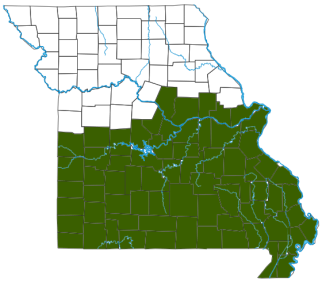
Occurs throughout the southern half of the state.
Habitat and Conservation
In Missouri, river cooters are usually active between April and October. This species is aquatic and lives in rivers and sloughs as well as larger reservoirs. It is rarely seen traveling on land, except for females in search of egg-laying sites.
River cooters spend a considerable amount of time basking on logs and will quickly slide into the water at the slightest disturbance.
Winter dormancy takes place in mud at the bottom of rivers, river sloughs, or lakes. This species has been observed basking in the sun on warm days in winter.
Food
River cooters are predominantly vegetarian and consume a wide variety of aquatic plants. A two-year study in a southwest Missouri reservoir found that up to 90 percent of their diet consisted of various species of green algae. Large, floating mats of a mixture of algae were available to turtles in the coves where the turtles were captured. The most abundant algae was the filamentous green algae Spirogyra. In addition to algae, mulberries that have fallen into the water were readily eaten. Both males and females shared the same diet. Since algae and plant materials are hard to digest, the river cooter has an extremely long intestine to increase digestion efficiency.
Other studies have reported cooters eating mussels, crayfish, and insects. River cooters and other species of turtles have been recorded as feasting on 13-year periodical cicadas as they dropped into the water at the Lake of the Ozarks.
During the active season, they forage for food during early morning and late afternoon.
Status
Little is known about the river cooter population in Missouri, but the species appears to be secure, especially within its preferred habitat.
Life Cycle
Courtship and mating occur in the water, and in Missouri, egg-laying apparently takes place in late May through June. The female digs her nest in loose soil or sand away from the aquatic habitat; one researcher documented a nest being dug some 50 feet from the water's edge. Throughout their range, river cooters are known to deposit multiple clutches that contain 4–30 eggs (average 15 eggs) each year. A study of river cooters in Arkansas found that females produced 2 or 3 clutches per season, with each clutch containing 9–18 eggs. A study in southwestern Missouri found clutch size was 12–28 eggs, with 2 or 3 clutches of eggs per season. The eggs mainly hatch during August and into September with an incubation period of 70–96 days.
Hatchlings may overwinter in the nest and emerge the following spring.
Male river cooters probably begin breeding at about 6 years of age; females mature at age 10 or older. Individuals in the wild likely live to 40 years of age or older.
Human Connections
The river cooter and several other turtle species were annually harvested by licensed commercial fisherman from rivers in southeastern Missouri — even though they were not considered a commercial species in this state. They were illegally sold alive to regional fish or turtle dealers, who shipped them to Asian markets, where they were sold for human consumption. Recent changes that stopped commercial harvest in Missouri will ensure this species and other turtle species remain common in Missouri.
The word “cooter” has African roots, arriving with enslaved people in the American South in the 1830s. It is from the Bambara or Malinke word “kuta” (turtle). In Ozark dialect, “cooter” could mean nearly any hard-shelled turtle; it was also a verb meaning “wander aimlessly”: “He was a-cooterin’ round amongst the womenfolks.”
The species name, concinna, is a Latin adjective meaning neat, elegant, clever, pretty, or pleasing. Apparently it refers to the elaborate, handsome markings on this turtle's carapace.
Ecosystem Connections
Cooters graze on aquatic plants and are eaten by a variety of animals. Eggs and young turtles are most vulnerable to predators. Nest predators include raccoons, skunks, and foxes. Newly hatched young may be eaten by large bass, great blue herons, and river otters.
Turtles and tortoises represent the oldest living group of reptiles on earth and are little-changed since the Triassic Period.
The eastern river cooter is a member of family Emydidae (the pond and box turtle family). This is one of the largest families of living turtles in the world. It comprises 12 genera, containing 52 species. In general, turtles in this family are small to medium sized and are adapted to a variety of habitats. This family includes several colorful species. Although the majority of species are aquatic (such as the eastern river cooter), several kinds are either semiaquatic or have taken to life on land (for example, the box turtles). In Missouri, this family is represented by 7 genera with a total of 11 species and 1 additional subspecies.
